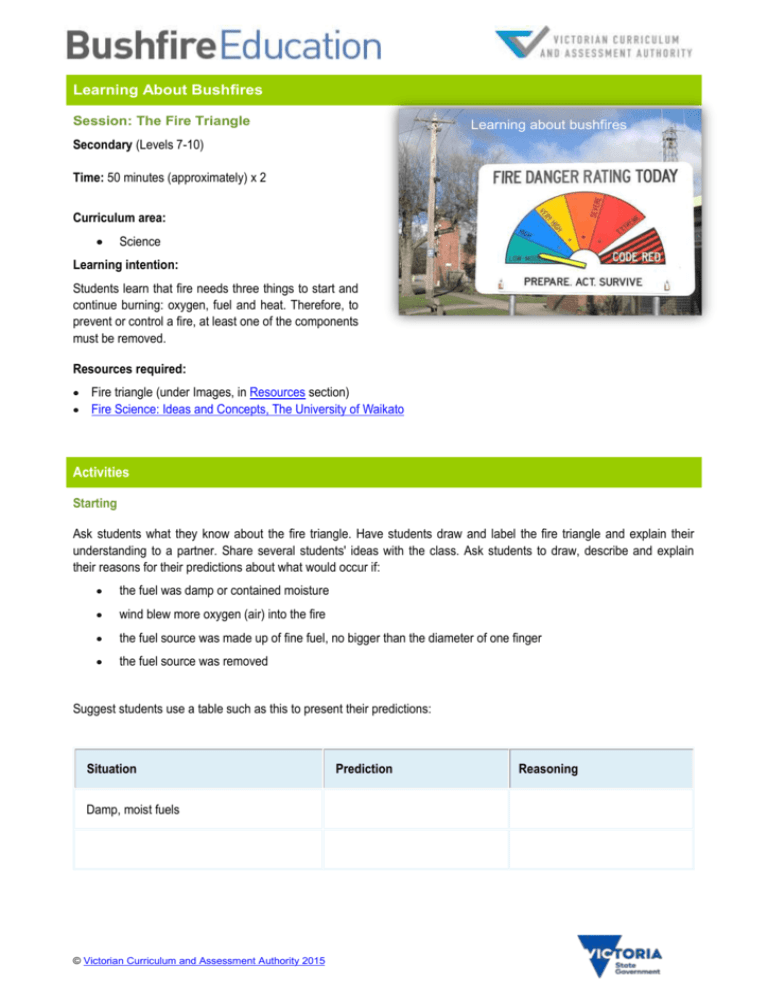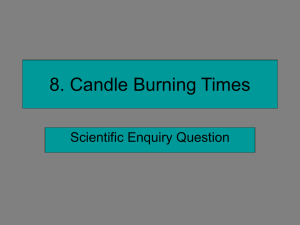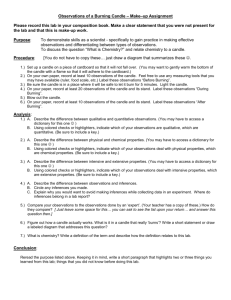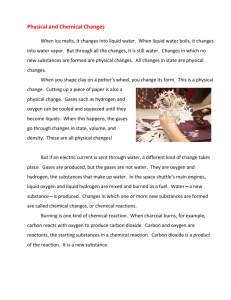Learning about bushfires: The Fire Triangle
advertisement

Learning About Bushfires Session: The Fire Triangle Learning about bushfires Secondary (Levels 7-10) Time: 50 minutes (approximately) x 2 Curriculum area: Science Learning intention: Students learn that fire needs three things to start and continue burning: oxygen, fuel and heat. Therefore, to prevent or control a fire, at least one of the components must be removed. Resources required: Fire triangle (under Images, in Resources section) Fire Science: Ideas and Concepts, The University of Waikato Activities Starting Ask students what they know about the fire triangle. Have students draw and label the fire triangle and explain their understanding to a partner. Share several students' ideas with the class. Ask students to draw, describe and explain their reasons for their predictions about what would occur if: the fuel was damp or contained moisture wind blew more oxygen (air) into the fire the fuel source was made up of fine fuel, no bigger than the diameter of one finger the fuel source was removed Suggest students use a table such as this to present their predictions: Situation Damp, moist fuels © Victorian Curriculum and Assessment Authority 2015 Prediction Reasoning Exploring Predict, observe, explain (POE) Set up several investigations for students using the Predict, Observe, Explain (POE) strategy. Advice: Teachers conducting demonstrations are advised to trial the activity prior to the session to be aware of any inherent safety requirements and potential issues. Demonstrations that involve burning should be undertaken in a fume cupboard or in a well-ventilated area. Check for smoke alarms that may be triggered by demonstrations involving burning. Safety: Make students aware of safety instructions for working with a flame. Ensure the bench is clear of any flammable materials. Have a heat-proof mat, a container of water to extinguish the burning match and a damp towel to smother the candle if required. Investigation 1: Oxygen Materials required per group of students: all students: a heat-proof mat, a container of water, matches, a damp towel, two candles, a glass jar, a larger glass jar in addition, for level 9-10 students: a tall glass cylinder with lid, limewater Have students work in pairs following strict safety procedures to predict what will occur if a lit candle is covered with an upturned glass jar. On the second observation have students measure the time taken for the flame to go out. Students may observe a small amount of condensation appearing on the sides of the glass jar. They may also feel the heat from the candle. Students explain their observations and relate to the fire triangle. Students use the POE strategy to investigate what occurs in each of the following situations. A much larger jar is used to cover the lit candle. (Students make the connection that the larger the jar the more oxygen is available and the longer the candle will stay alight.) Two candles are covered by the one over turned glass jar. (Students make the connection that two candles will require more oxygen than one, so the oxygen will be used up quicker causing the flame to go out faster.) A lit candle is sitting in a tray of water with the over turned glass jar placed over the candle. (Students make the connection that as the candle uses up the oxygen the difference in pressure will cause the water level in the tray © VCAA 2015 Page 2 to rise and take up some of the space left by the oxygen.) For levels 9-10: Wear safety glasses for this experiment. Place a tall glass cylinder over a lit candle. Once the candle flame is extinguished invert the jar and place a cap over the top capturing the gases inside. Remove the cap and pour in approximately 50 mL of limewater. Replace the cap and shake the contents. Students should observe that the clear solution turns cloudy. Limewater is calcium hydroxide Ca(OH)2. The change from a clear solution to one that is cloudy indicates the presence of carbon dioxide, CO 2. The cloudiness observed is caused by the suspended calcium carbonate, CaCO 3. When CO2 is passed through limewater a chemical reaction takes place that converts the calcium hydroxide to calcium carbonate, CaCO3. Students should conclude that burning (combustion) produces carbon dioxide. In each case have students predict, observe and explain what occurred. They can refer to evidence such as measurements taken, for instance time elapsed before the flame extinguished. Most students will describe the reason for the fire being extinguished as the lack of oxygen. Also discuss the gas that was produced, CO 2, and the fact that it is non-combustible. The reason for the fire going out is a combination of lack of oxygen and an increased level of carbon dioxide. Explain that burning is a combustion reaction - involving oxygen, O2 - and that combustion reactions produce heat. In the example of burning paper, water vapour (H2O) and carbon dioxide (CO2) are produced with the remaining product, ash. In general, a blue flame indicates complete combustion, where water vapour and carbon dioxide are produced. A yellow flame and smoke is evidence that there was an incomplete combustion as not enough oxygen was available. The combination of particles of unburnt material such as carbon and other gases is what we see as smoke. Investigation 2: Fuel Materials required per group of students: a heat-proof mat a container of water matches a damp towel 6-8 dry eucalyptus leaves Following safety procedures, students investigate burning dry eucalyptus leaves in a fume cupboard or well-ventilated area. On a heat-proof mat students light 3 or 4 dry leaves. They add a leaf and observe what happens. They add another leaf and another leaf and observe what happens. No other leaves are added. They predict, observe and explain what happens. Investigation 3: Heat Materials required per group of students: a heat-proof mat a container of water matches a damp towel 3-4 dry eucalyptus leaves 3-4 green eucalyptus leaves a tripod stand © VCAA 2015 Page 3 a Bunsen burner and sheet of metal Set up the following activity as a demonstration or student investigation: Set up a tripod stand and a Bunsen burner on a heat mat. Place a thin metal sheet over the burner. Place 3 or 4 dry eucalyptus leaves on the metal sheet. Students predict, observe and explain what happens. In discussion, introduce the term 'ignition temperature' to explain the temperature at which a material will ignite and start to burn. Compare the dry eucalyptus leaves with some green (just picked) eucalyptus leaves. Describe differences in ignition. Relate this to the moisture content of each leaf (fuel). Ensure students make the connection that the fuel did not need to be in direct contact with a flame to ignite. Bringing it together After the investigations, refer students back to the table created at the beginning of the session. Ask them to review and update it after the POE investigations and discussion. Situation Prediction Reasoning Damp, moist fuels Relate what students discovered about fire and the concept of the fire triangle to a bushfire. In a bushfire what are potential fuels? How can those fuels ignite? How does wind support the continued burning and the spread of bushfires? Use the Fire Triangle to explain how a lightning strike can start a bushfire. Vocabulary burning, carbon dioxide, extinguish, fuel, heat, ignite, oxygen, smother, smoke, combustion, water vapour Extending Not applicable to this session. © VCAA 2015 Page 4







